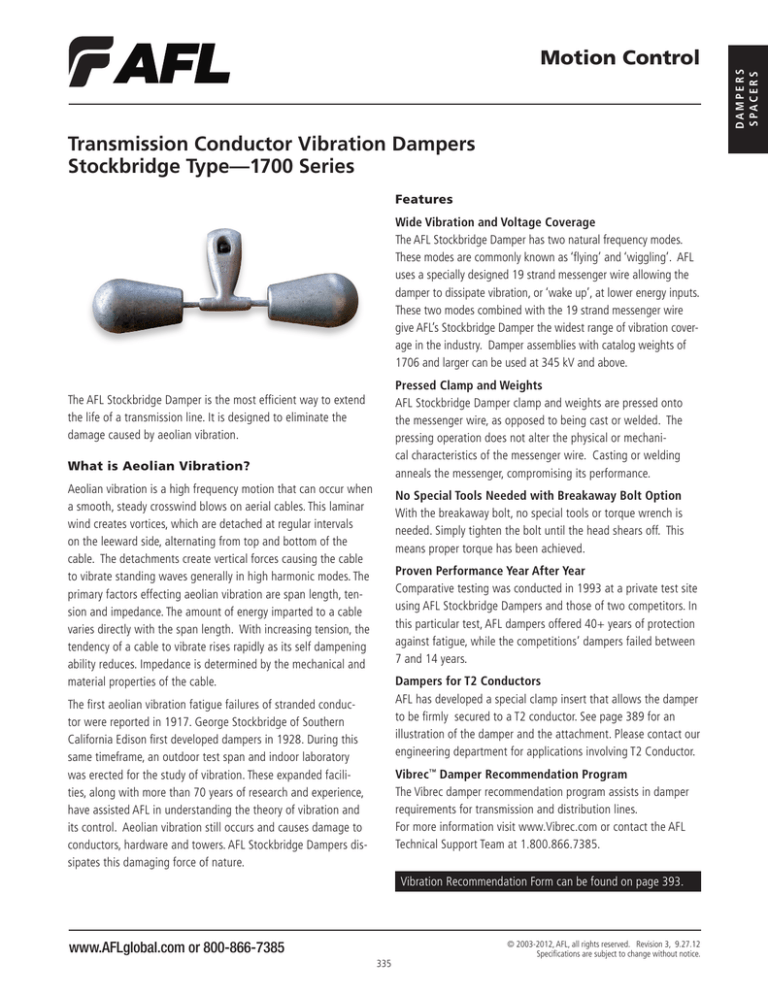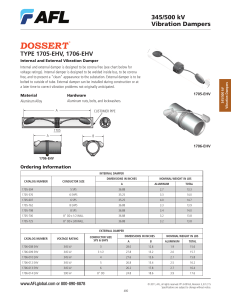
Transmission Conductor Vibration Dampers
Stockbridge Type—1700 Series
Features
Wide Vibration and Voltage Coverage
The AFL Stockbridge Damper has two natural frequency modes.
These modes are commonly known as ‘flying’ and ‘wiggling’. AFL
uses a specially designed 19 strand messenger wire allowing the
damper to dissipate vibration, or ‘wake up’, at lower energy inputs.
These two modes combined with the 19 strand messenger wire
give AFL’s Stockbridge Damper the widest range of vibration coverage in the industry. Damper assemblies with catalog weights of
1706 and larger can be used at 345 kV and above.
Pressed Clamp and Weights
AFL Stockbridge Damper clamp and weights are pressed onto
the messenger wire, as opposed to being cast or welded. The
pressing operation does not alter the physical or mechanical characteristics of the messenger wire. Casting or welding
anneals the messenger, compromising its performance.
The AFL Stockbridge Damper is the most efficient way to extend
the life of a transmission line. It is designed to eliminate the
damage caused by aeolian vibration.
What is Aeolian Vibration?
Aeolian vibration is a high frequency motion that can occur when
a smooth, steady crosswind blows on aerial cables. This laminar
wind creates vortices, which are detached at regular intervals
on the leeward side, alternating from top and bottom of the
cable. The detachments create vertical forces causing the cable
to vibrate standing waves generally in high harmonic modes. The
primary factors effecting aeolian vibration are span length, tension and impedance. The amount of energy imparted to a cable
varies directly with the span length. With increasing tension, the
tendency of a cable to vibrate rises rapidly as its self dampening
ability reduces. Impedance is determined by the mechanical and
material properties of the cable.
No Special Tools Needed with Breakaway Bolt Option
With the breakaway bolt, no special tools or torque wrench is
needed. Simply tighten the bolt until the head shears off. This
means proper torque has been achieved.
Proven Performance Year After Year
Comparative testing was conducted in 1993 at a private test site
using AFL Stockbridge Dampers and those of two competitors. In
this particular test, AFL dampers offered 40+ years of protection
against fatigue, while the competitions’ dampers failed between
7 and 14 years.
Dampers for T2 Conductors
AFL has developed a special clamp insert that allows the damper
to be firmly secured to a T2 conductor. See page 389 for an
illustration of the damper and the attachment. Please contact our
engineering department for applications involving T2 Conductor.
The first aeolian vibration fatigue failures of stranded conductor were reported in 1917. George Stockbridge of Southern
California Edison first developed dampers in 1928. During this
same timeframe, an outdoor test span and indoor laboratory
was erected for the study of vibration. These expanded facilities, along with more than 70 years of research and experience,
have assisted AFL in understanding the theory of vibration and
its control. Aeolian vibration still occurs and causes damage to
conductors, hardware and towers. AFL Stockbridge Dampers dissipates this damaging force of nature.
Vibrec™ Damper Recommendation Program
The Vibrec damper recommendation program assists in damper
requirements for transmission and distribution lines.
For more information visit www.Vibrec.com or contact the AFL
Technical Support Team at 1.800.866.7385.
Vibration Recommendation Form can be found on page 393.
www.AFLglobal.com or 800-866-7385
335
© 2003-2012, AFL, all rights reserved. Revision 3, 9.27.12
Specifications are subject to change without notice.
DAMPERS
S PA C E R S
Motion Control
DAMPERS
S PA C E R S
Motion Control
Transmission Conductor Vibration Dampers
Stockbridge Type—1700 Series (cont.)
Table 1: Weight Selection
WEIGHT
CATALOG
NUMBER
Ordering Instructions
BARE CONDUCTOR DIAMETER RANGE
IN
MM
Step 1: Determine Conductor Diameter
All damper ordering is based on the diameter of the conductor
being used.
WEIGHT 2
STEEL
LBS
KG
Step 2: Select Weight Catalog Number
Use Table 1 to select the correct weight catalog number based on
the diameter of the bare conductor being used.
GALVANIZED STEEL, ALUMOWELD®, OR COPPERWELD®
1701
1702
1
1
1703
1704
1705
1706 3
1707 3
1708 3
0.270 - 0.430
0.431 - 0.630
0.361 - 0.570
0.571 - 0.770
0.771 - 0.970
0.971 - 1.210
1.211 - 1.382
1.383 - 1.825
6.9 - 10.9
11.0 - 16.0
Aluminum Conductor
9.2 - 14.4
14.5 - 19.5
19.6 - 24.6
24.7 - 30.7
30.8 - 35.1
35.2 - 46.4
2.6
5.5
1.18
2.49
2.9
6.5
9.9
13.3
19.7
28.8
1.32
2.95
4.49
6.03
8.94
13.06
Step 3: Select Clamp Catalog Number
Before selecting a Clamp, ask one question ‘Does this application
require placement of clamp over armor rods?’
If yes, select the correct clamp catalog number from Table 2
based on the total diameter of the conductor and the armor rods.
If no, select the correct clamp catalog number from Table 2 based
on the diameter of the bare conductor being used.
Table 2: Clamp Selection
CLAMP
AFL NO.
-2
-3
-4
-5
-6
-7
-8
-9 3
-10 3
-11 3
-13 3
-14 3
-15 3
-16 3
-17 3
-18 3
-19 3
OVERALL DIAMETER RANGE
AT POINT OF INSTALLATION
IN
MM
CLAMP
BOLT
DIA 4
0.270 - 0.360
0.361 - 0.460
0.461 - 0.570
0.571 - 0.675
0.676 - 0.770
0.771 - 0.870
0.871 - 0.970
0.971 - 1.090
1.091 - 1.210
1.211 - 1.330
1.331 - 1.486
1.487 - 1.643
1.644 - 1.780
1.781 - 1.960
1.961 - 2.157
2.158 - 2.375
2.376 - 2.614
6.9 - 9.1
9.2 - 11.6
11.7 - 14.4
14.5 - 17.1
17.2 - 19.8
19.6 - 22.1
22.2 - 24.6
24.7 - 27.6
27.7 - 30.7
30.8 - 33.7
33.8 - 37.7
37.8 - 41.7
41.8 - 45.2
45.3 - 49.7
49.8 - 54.7
54.8 - 60.3
60.4 - 66.4
7/16
7/16
7/16
7/16
7/16
1/2
1/2
1/2
1/2
1/2
5/8
5/8
5/8
5/8
5/8
5/8
5/8
Step 4: Select Bolts
For breakaway bolts, use ‘BA’. For standard bolts, leave blank.
WEIGHT 2
ALUMINUM
LBS
KG
0.3
0.3
0.3
0.4
0.4
0.6
0.6
1.1
1.1
1.1
1.6
1.5
1.5
2.2
2.2
2.4
2.4
0.15
0.15
0.15
0.16
0.15
0.26
0.26
0.50
0.50
0.50
0.73
0.68
0.68
1.00
1.00
1.09
1.09
Step 5: Create Catalog Number
Weight Catalog Number
+
Clamp Catalog Number
+
Bolts
Example:
Without Armor Rods
Conductor Diameter: 1.108" (28.1mm)
Weight Size from Table 1: 1706
Clamp Size from Table 2: -10
Bolts: Breakaway
Catalog Number: 1706-10BA
With Armor Rods
Conductor Diameter: 1.108" (28.1mm)
Weight Size from Table 1: 1706
Diameter of Conductor and Armor Rods: 1.728" (43.9 mm)
Clamp Size from table 2: -15
Bolts: Standard
Catalog Number: 1706-15
Notes:
1. Catalog 1701 and 1702 weights are for galvanized stranded steel, copper clad
and aluminum clad steel (e.g. Copperweld®, Alumoweld®).
2. Steel weight shown in Table 1 includes both damper weights and other steel
parts used. For complete weight of damper assembly, add partial weights
shown in Tables 1 and 2.
3. Damper assemblies with 1706, 1707, or 1708 weight catalog numbers and
–9 clamp catalog numbers or larger can be used at 345 kV and above.
4. Regular aluminum hexagon head bolts are standard on assemblies that have
1705 weights and smaller. Assemblies having 1706 weights and larger have
special Corona hexagon head bolts.
5. For conductor sizes not covered in the table, consult AFL Technical Support Team
at 1.800.866.7385.
6. Installation instructions for dampers are on page 385.
www.AFLglobal.com or 800-866-7385
336
© 2003-2012, AFL, all rights reserved. Revision 3, 9.27.12
Specifications are subject to change without notice.


